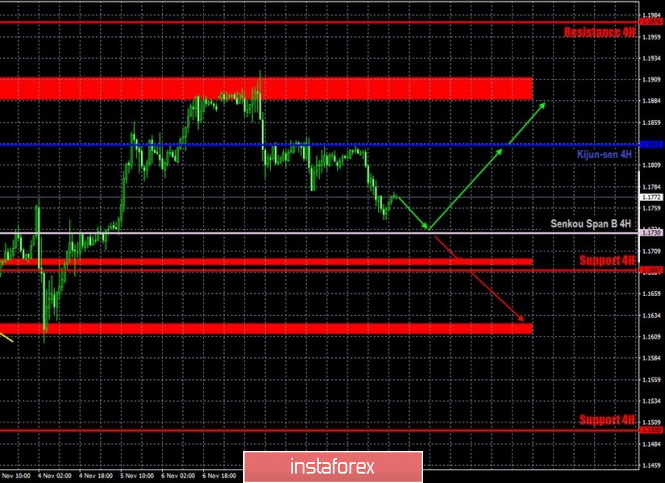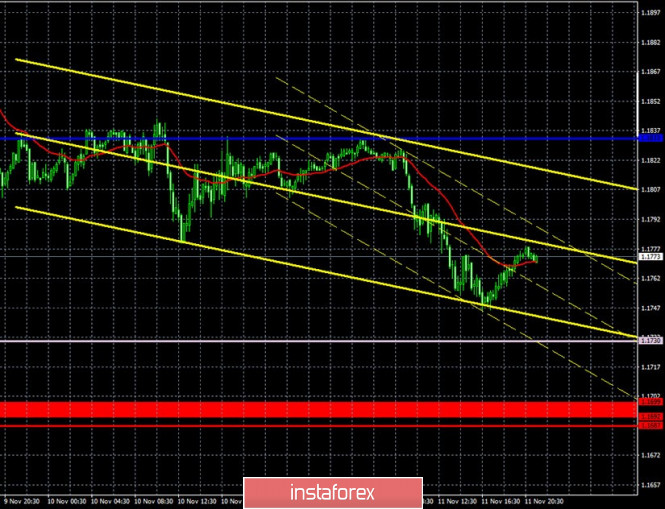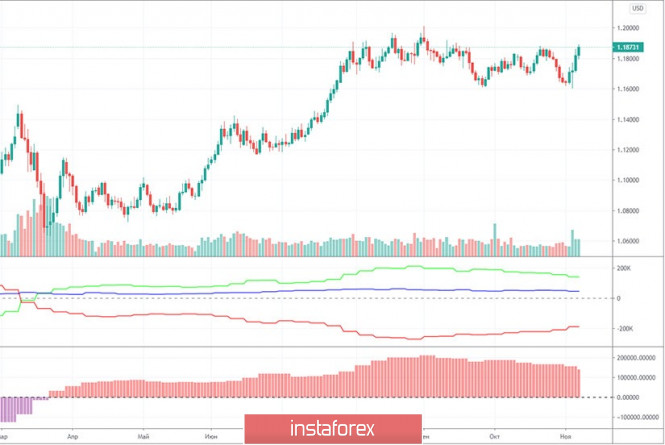EUR/USD 1H

The EUR/USD pair continued to move down on the hourly timeframe on Wednesday, November 11. Thus, after failing to overcome the resistance area of 1.1886-1.1912, the bears continue to put pressure on the pair. A day earlier, we predicted that if the Kijun-sen line was crossed, the pair would continue moving down to the Senkou Span B line. And so it happened. The only thing is that the price has not yet had time to fall to the Senkou Span B line, and the Kijun-sen line itself went above the pair's quotes. However, in general, the pair will continue moving down. Sellers still have many significant barriers ahead. In particular, it will be necessary to overcome the Senkou Span B line, which is one of the last frontiers before forming a downward trend. However, take note of several important points. Firstly, the price rebounded from the upper line of the horizontal channel at $1.17-1.19, so it is likely for it to fall to 1.1700. Second, there is still no trendline or trend channel, so the current downward trend is not strong. The biggest question now is how the pair will behave around the 1.1700 level. Tension in the foreign exchange market continues to subside, as the elections are left behind, and Donald Trump has not yet begun to implement his plan to revise the voting results, in addition to various kinds of threats. Therefore, the dollar really can still rise.
EUR/USD 15M

Both linear regression channels are directed to the downside on the 15-minute timeframe. However, the key moment now is the price rebounding from the 1.1886-1.1912 area, which triggered a downward movement, which is still corrective. In order for it to fall further, sellers need to confidently overcome the Senkou Span B line. This line is also the closest target. There are no signs of completing the downward movement on the lower timeframe.
COT report

The EUR/USD pair lost 170 points during the last reporting week (October 27-November 2). A strong upward movement began after this time range. Therefore, the fact that the pair gained 220 points simply does not fall within the timeframe of the latest Commitment of Traders (COT) report. According to it, professional traders closed 9,200 Buy-contracts (longs) and opened 7,800 Sell-contracts (shorts). Thus, the net position for non-commercial traders decreased by 17,000 at once. And any decrease in the net position indicates a strengthening of the bearish mood. Consequently, professional traders continue to look towards selling the euro. Therefore, even despite the subsequent growth, we still believe that the high near the 1.2000 level will still be the peak of the entire upward trend. At least the COT data continues to signal just that. The technical analysis may contradict the COT report, as the latter comes out with a three-day delay. We cannot now know how the big players behaved in the period from November 3 to 6, which is when the dollar was significantly falling due to the elections. Indicators are also signaling good prospects for a new downward trend, as the green and red lines continue to narrow (the first indicator). And they, we recall, reflect the net positions of non-commercial traders and commercial ones.
The fundamental background was rather weak on Wednesday. Not a single important macroeconomic report. European Central Bank President Christine Lagarde delivered a speech, but she did not say anything extra interesting. And in any case, it could hardly provide support to the European currency, since the situation with the coronavirus remains difficult in Europe, which means that the economy will begin to slow down at best, and contract at worst. Consequently, it may need new incentives, as Lagarde mentioned on Wednesday. Also take note of Donald Trump's attacks, who continues to threaten to revise the election results and has already announced "great progress" and "results next week." The US president did not provide any details about it.
Germany is set to publish its consumer price index for October, which is forecast to remain at -0.2% y/y. Harmonized inflation is also likely to remain negative at -0.5% y/y. EU industrial production in September is forecast at +0.7% compared to August, which is not much. US Inflation should be 1.3%-1.4% on an annualized basis. Lagarde is also set to deliver another speech today. Therefore, all macroeconomic reports look as neutral as possible so far, and only strong deviations of actual values from forecasts can cause a reaction from traders.
We have two trading ideas for November 12:
1) Buyers need to wait until they have gone beyond the 1.1886-1.1912 area in order to open new buy positions on the pair with the nearest target at the resistance level of 1.1976. Or wait for the price to rebound from the Senkou Span B line (1.1730) and trade up while aiming for the Kijun-sen line (1.1833) and the resistance area of 1.1886-1.1912. Take Profit in the first case will be up to 50 points, in the second - up to 120 points.
2) Bears took the pair below the critical line. However, they now need to break the Senkou Span B line (1.1730) in order to continue trading down with support targets at 1.1692-1.1699 and 1.1612-1.1624. Take Profit in this case can range from 20 to 90 points.
Hot forecast and trading signals for GBP/USD
Explanations for illustrations:
Support and Resistance Levels are the levels that serve as targets when buying or selling the pair. You can place Take Profit near these levels.
Kijun-sen and Senkou Span B lines are lines of the Ichimoku indicator transferred to the hourly timeframe from the 4-hour one.
Support and resistance areas are areas from which the price has repeatedly rebounded off.
Yellow lines are trend lines, trend channels and any other technical patterns.
Indicator 1 on the COT charts is the size of the net position of each category of traders.
Indicator 2 on the COT charts is the size of the net position for the "non-commercial" group.
The material has been provided by InstaForex Company - www.instaforex.com